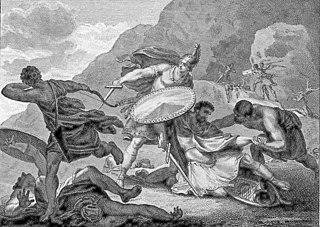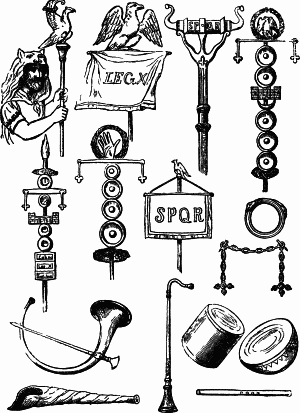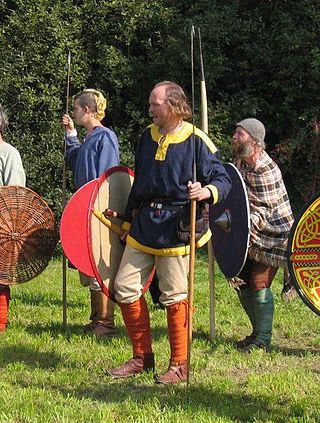The Roman legion, the largest military unit of the Roman army, was composed of Roman citizens serving as legionaries. During the Roman Republic the manipular legion comprised 4,200 infantry and 300 cavalry. After the Marian reforms in 107 BC the legions were formed of 5200 men and were restructured around 10 cohorts, the first cohort being double strength. This structure persisted throughout the Principate and Middle Empire, before further changes in the fourth century resulted in new formations of around 1000 men.
A spear is a polearm consisting of a shaft, usually of wood, with a pointed head. The head may be simply the sharpened end of the shaft itself, as is the case with fire hardened spears, or it may be made of a more durable material fastened to the shaft, such as bone, flint, obsidian, copper, bronze, iron, or steel. The most common design for hunting and/or warfare, since ancient times has incorporated a metal spearhead shaped like a triangle, diamond, or leaf. The heads of fishing spears usually feature multiple sharp points, with or without barbs.
The pilum was a javelin commonly used by the Roman army in ancient times. It was generally about 2 m long overall, consisting of an iron shank about 7 mm (0.28 in) in diameter and 600 mm (24 in) long with a pyramidal head, attached to a wooden shaft by either a socket or a flat tang.
The Battle of Zama was fought in 202 BC in what is now Tunisia between a Roman army commanded by Scipio Africanus and a Carthaginian army commanded by Hannibal. The battle was part of the Second Punic War and resulted in such a severe defeat for the Carthaginians that they capitulated, while Hannibal was forced into exile. The Roman army of approximately 30,000 men was outnumbered by the Carthaginians who fielded either 40,000 or 50,000; the Romans were stronger in cavalry, but the Carthaginians had 80 war elephants.

The battle of the Trebia was the first major battle of the Second Punic War, fought between the Carthaginian forces of Hannibal and a Roman army under Sempronius Longus on 22 or 23 December 218 BC. Each army had a strength of about 40,000 men; the Carthaginians were stronger in cavalry, the Romans in infantry. The battle took place on the flood plain of the west bank of the lower Trebia River, not far from the settlement of Placentia, and resulted in a heavy defeat for the Romans.

A peltast was a type of light infantry originating in Thrace and Paeonia and named after the kind of shield he carried. Thucydides mentions the Thracian peltasts, while Xenophon in the Anabasis distinguishes the Thracian and Greek peltast troops.

The sarissa or sarisa was a long spear or pike about 5 to 7 meters in length. It was introduced by Philip II of Macedon and was used in his Macedonian phalanxes as a replacement for the earlier dory, which was considerably shorter. These longer spears improved the strength of the phalanx by extending the rows of overlapping weapons projecting towards the enemy. After the conquests of Alexander the Great, the sarissa was a mainstay during the Hellenistic era by the Hellenistic armies of the diadochi Greek successor states of Alexander's empire, as well as some of their rivals.

The battle of Ticinus was fought between the Carthaginian forces of Hannibal and a Roman army under Publius Cornelius Scipio in late November 218 BC as part of the Second Punic War. It took place in the flat country on the right bank of the river Ticinus, to the west of modern Pavia in northern Italy. Hannibal led 6,000 Libyan and Iberian cavalry, while Scipio led 3,600 Roman, Italian and Gallic cavalry and a large but unknown number of light infantry javelinmen.
A spiculum is a late Roman spear that replaced the pilum as the infantryman's main throwing javelin around 250 AD. Scholars suppose that it could have resulted from the gradual combination of the pilum and two German spears, the angon and the bebra. As more and more Germans joined the Roman army, their culture and traditions became a driving force for change. The spiculum was better than the old pilum when used as a thrusting spear, but still maintained some of the former weapon's penetrative power when thrown.
The hasta was the spear carried by early Roman legionaries, for which the Roman soldiers known as hastati were named. In later republican times, the hastati were re-armed with pila and gladii, and the hasta was only retained by the triarii.
Soliferrum or Soliferreum was the Roman name for an ancient Iberian ranged polearm made entirely of iron. The soliferrum was a heavy hand-thrown javelin, designed to be thrown to a distance of up to 30 meters. In the Iberian language it was known as Saunion.

Roman military personal equipment was produced in large numbers to established patterns, and used in an established manner. These standard patterns and uses were called the res militaris or disciplina. Its regular practice during the Roman Republic and Roman Empire led to military excellence and victory. The equipment gave the Romans a very distinct advantage over their barbarian enemies, especially so in the case of armour. This does not mean that every Roman soldier had better equipment than the richer men among his opponents. Roman equipment was not of a better quality than that used by the majority of Rome's adversaries. Other historians and writers have stated that the Roman army's need for large quantities of "mass produced" equipment after the so-called "Marian Reforms" and subsequent civil wars led to a decline in the quality of Roman equipment compared to the earlier Republican era:
The production of these kinds of helmets of Italic tradition decreased in quality because of the demands of equipping huge armies, especially during civil wars...The bad quality of these helmets is recorded by the sources describing how sometimes they were covered by wicker protections, like those of Pompeius' soldiers during the siege of Dyrrachium in 48 BC, which were seriously damaged by the missiles of Caesar's slingers and archers.
It would appear that armour quality suffered at times when mass production methods were being used to meet the increased demand which was very high the reduced size cuirasses would also have been quicker and cheaper to produce, which may have been a deciding factor at times of financial crisis, or where large bodies of men were required to be mobilized at short notice, possibly reflected in the poor-quality, mass produced iron helmets of Imperial Italic type C, as found, for example, in the River Po at Cremona, associated with the Civil Wars of AD 69 AD; Russell Robinson, 1975, 67
Up until then, the quality of helmets had been fairly consistent and the bowls well decorated and finished. However, after the Marian Reforms, with their resultant influx of the poorest citizens into the army, there must inevitably have been a massive demand for cheaper equipment, a situation which can only have been exacerbated by the Civil Wars...

A javelin is a light spear designed primarily to be thrown, historically as a ranged weapon. Today, the javelin is predominantly used for sporting purposes such as the Javelin throw. The javelin is nearly always thrown by hand, unlike the sling, bow, and crossbow, which launch projectiles with the aid of a hand-held mechanism. However, devices do exist to assist the javelin thrower in achieving greater distances, such as spear-throwers or the amentum.

In Ancient Greek armies, the psiloi were the light infantry who usually acted as skirmishers and missile troops, and who were distinguished from the armored hoplitai by their light weapons and lack of armor.

The angon was a type of javelin used during the Early Middle Ages by the Anglo-Saxons, Franks, Goths, and other Germanic peoples. It was similar to, and probably derived from, the pilum used by the Roman army and had a barbed head and long narrow socket or shank made of iron mounted on a wooden haft.

Velites were a class of infantry in the Roman army of the mid-Republic from 211 to 107 BC. Velites were light infantry and skirmishers armed with javelins, each with a 75cm wooden shaft the diameter of a finger, with a 25cm narrow metal point, to fling at the enemy. They also carried short thrusting swords, or gladii, for use in melee. They rarely wore armour as they were the youngest and poorest soldiers in the legion and could not afford much equipment. They did carry small wooden shields called parma for protection, and wore headdresses made from wolf skins so their brave deeds could be recognized. The velites were placed at the front partly for tactical reasons, and also so that they had the opportunity to secure glory for themselves in single combat.
Hastati were a class of infantry employed in the armies of the early Roman Republic, who originally fought as spearmen and later as swordsmen. These soldiers were the staple unit after Rome threw off Etruscan rule. They were originally some of the poorest men in the legion, and could afford only modest equipment—light chainmail and other miscellaneous equipment. The Senate supplied their soldiers with only a short stabbing sword, the gladius, and their distinctive squared shield, the scutum. The hastatus was typically equipped with these, and one or two soft iron tipped throwing spears called pila. This doubled their effectiveness, not only as a strong leading edge to their maniple, but also as a stand-alone missile troop. Later, the hastati contained the younger men rather than just the poorer, though most men of their age were relatively poor. Their usual position was the first battle line. They fought in a quincunx formation, supported by lighter infantry. The enemy was allowed to penetrate the first battle line consisting of hastati, after which the enemy would deal with the more hardened, seasoned soldiers, the principes. They were eventually disbanded after the so-called "Marian reforms" of 107 BC.
Principes were spearmen, and later swordsmen, in the armies of the early Roman Republic. They were men in the prime of their lives who were fairly wealthy, and could afford decent equipment. They were the heavier infantry of the legion who carried large shields and wore good quality armor.

The Roman army of the mid-Republic, also called the manipular Roman army or the Polybian army, refers to the armed forces deployed by the mid-Roman Republic, from the end of the Samnite Wars to the end of the Social War. The first phase of this army, in its manipular structure, is described in detail in the Histories of the ancient Greek historian Polybius, writing before 146 BC.

The Roman army of the late Republic refers to the armed forces deployed by the late Roman Republic, from the beginning of the first century BC until the establishment of the Imperial Roman army by Augustus in 30 BC.











